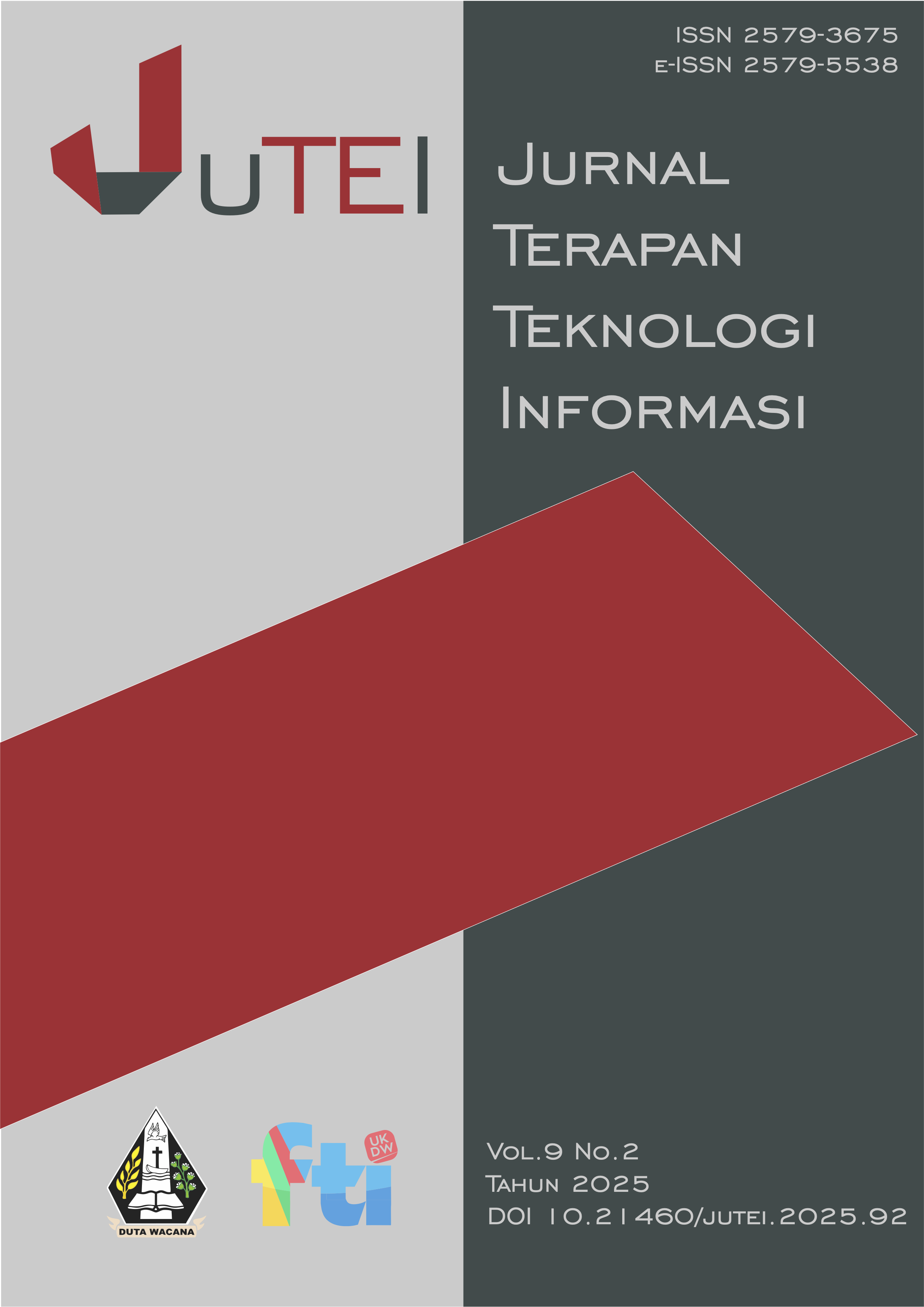Perancangan Website TMLESS Studio dengan Metode Design Thinking
DOI:
https://doi.org/10.21460/jutei.2025.92.378Keywords:
website, Design Thinking, empathize, define, ideate, prototype, test, Single Ease Question, Google Sites, Google FormAbstract
TMLESS Studio is an entertainment company based in Yogyakarta, Indonesia, which is engaged in content creation ranging from films and music videos to series and documentation. The documentation service offerings provided by TMLESS Studio are still carried out by introducing themselves directly to prospective customers or with the help of old customers who recommend their services to prospective customers. TMLESS Studio has tried to use social media as a marketing medium, but this is still considered to have no impact on service sales. The solution that will be carried out to help solve this problem is to design a website to display complete information on TMLESS Studio's work and documentation service offerings in one area.
The TMLESS Studio website will be designed using the Design Thinking method which includes 5 stages, namely empathize, define, ideate, prototype, and test. At the test stage, testing will be carried out using the Single Ease Question (SEQ) using the help of Google Sites and Google Form to find out whether the tested website can overcome the initial problem.
The results of the SEQ respondent data average test show that the website being tested is in the very easy category (average = 6.19). The results of the average test of Tasks 5, 6, 7, and 8 regarding information on works and services offered by TMLESS Studio are in the very easy category. The results of this test show that the application of the stages of the Design Thinking method and the implementation of SEQ in the design of the TMLESS Studio website being tested has succeeded in overcoming the problems and can be used as a permanent TMLESS Studio website.
References
Hakim, L, “Jalan Pintas Menjadi Master PHP” edisi ke-1, Yogyakarta, Indonesia, 2009.
I. Nugroho. (2021) Blog on CIAS. [Online]. Tersedia: https://www.cias.co/post/apa-itu-design-thinking
I. M. Putra, D. R. Indah. (Juni 2023). Implementasi Metode Design Thinking Dalam Aplikasi Giwang Sumsel. KLIK: Kajian Ilmiah Informatika dan Komputer. [Online]. Vol 3, No 6, hal. 688-697. Tersedia: https://djournals.com/klik/article/view/872/529
T. N. A. Amini,H. Fabroyir, R. J. Akbar. (Agustus 2021). Desain dan Evaluasi Antarmuka Mobile App MyITS Alumni pada Platform Android dan Ios Melalui Pendekatan User-Centered Design. JURNAL TEKNIK ITS. [Online]. Vol. 10, No. 2, hal. A133-A138. Tersedia: https://media.neliti.com/media/publications/499721-none-32187985.pdf
R. P. Susanto. (Januari 2022). Analisis User Flow pada Website Pendidikan: Studi Kasus Website DKV UK Petra. Jurnal Desain Komunikasi Visual Nirmana. [Online]. Vol. 22, No. 1, hal. 41-51. Tersedia: https://nirmana.petra.ac.id/index.php/dkv/article/view/24709
R. Andrian, Ardiansyah, M. Fitria. (Maret 2020). Rancangan Prototipe Aplikasi Informasi Penyewaan Gedung Pernikahan di Banda Aceh. KITEKTRO: Jurnal Online Teknik Elektro. [Online]. Vol.5 No.1, hal. 19-27. Tersedia: https://jurnal.usk.ac.id/kitektro/article/download/15573/12380
F. I. Romadhanti, I. Aknuranda. (Oktober 2020). Evaluasi dan Perbaikan Desain Antarmuka Pengguna Sistem Informasi Musyawarah Masjid menggunakan Goal-Directed Design (GDD) (Studi Kasus : Masjid Ibnu Sina Jl.Veteran Malang). Jurnal Pengembangan Teknologi Informasi dan Ilmu Komputer. [Online]. Vol. 4, No. 10, hal. 3313-3321. Tersedia: https://j-ptiik.ub.ac.id/index.php/jptiik/article/view/7919/3733
W. Wulandari, A. D. Y. Widiantoro. (Mei-Agustus 2017). Design Data Flow Diagram for Supporting the User Experience in Applications. International Journal of the Computer, the Internet and Management. [Online]. Vol. 25, No. 2, pp. 14-20. Tersedia: https://repository.unika.ac.id/17139/1/jurnal_design%20dataflow%20diagram.pdf
N. Sudjana, “Penilaian Hasil Proses Belajar Mengajar” edisi ke-1, Bandung, Indonesia, 2016.
Kamus Besar Bahasa Indonesia (KBBI). (2016). [Online]. Tersedia: https://kbbi.kemdikbud.go.id/entri/Minimalis
Kamus Besar Bahasa Indonesia (KBBI). (2016). [Online]. Tersedia: https://kbbi.kemdikbud.go.id/entri/Kompleks
Kamus Besar Bahasa Indonesia (KBBI). (2016). [Online]. Tersedia: https://kbbi.kemdikbud.go.id/entri/Formal
Kamus Besar Bahasa Indonesia (KBBI). (2016). [Online]. Tersedia: https://kbbi.kemdikbud.go.id/entri/Informal
Downloads
Published
How to Cite
Issue
Section
License
Copyright (c) 2025 Yohanes Tennary Rinto Pradhana, Joko Purwadi, Raden Gunawan Santosa

This work is licensed under a Creative Commons Attribution-NonCommercial-NoDerivatives 4.0 International License.
Authors who publish articles in JUTEI agree on the following rules:
1. The author grants non exclusive royalty free rights, and is willing to publish articles online and complete (full access). With such rights JUTEI reserves the right to save, transfers, manages in various forms, maintains and publishes articles while keeping the author's name as the copyright owner.
2. Each author contained in the article has contributed fully to the substance and intellectual, and is accountable to the public. If in the future there is a copyright infringement notification then this will be responsibility of the author, not JUTEI.







